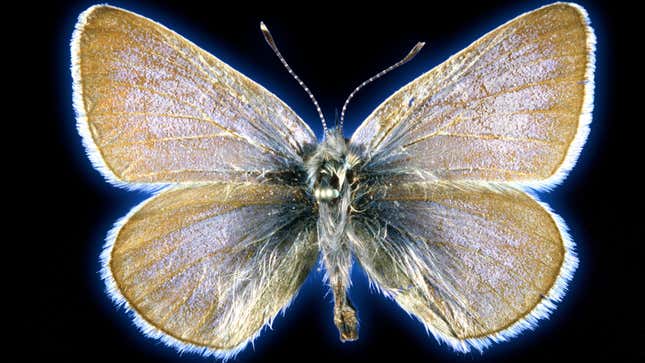
Scientists say they’ve confirmed a decades-old suspicion about the loss of the Xerces blue butterfly in the U.S by the 1940s. Based on genetic analysis of a 93-year-old specimen and others, they say the Xerces blue really was a distinct species of butterfly, rather than a sub-group of another existing species, as some scientists have speculated. If true, it would reaffirm the end of the butterfly as the first known insect extinction in the U.S. tied to urbanization.
The Xerces blue, or Glaucopsyche xerces, was native to the San Francisco Peninsula in California. The name actually only referenced male butterflies, since the front of their iridescent wings had a striking blue to violet coloring and black trim. Females had plainer brown wings. The last confirmed sighting of the Xerces blue took place in the early 1940s. And though there are related species of the butterfly still around today, it’s widely thought that its evolutionary journey ended soon after that, thanks in no small part to its growing loss of habitat caused by our development of new buildings and structures in the area.
The sad tale of the Xerces blue has motivated environmentalists ever since. In 1971, the Xerces Society, a nonprofit organization devoted to the conservation of insects and other invertebrates, was established, having adopted the butterfly as its mascot. More recently, some people have wondered if the Xerces blue would be an ideal candidate for de-extinction, the idea of bringing a species back to life. This could happen either through genetic engineering techniques (like Jurassic Park) or via the introduction of a closely related species to its once native habitat—in essence, trying to recreate the conditions that gave rise to the lost butterfly in the first place.

But some researchers have also wondered, given its close resemblance to other butterflies, if perhaps the Xerces blue should be more accurately considered a subspecies of another group still widely found today in the western half of North America: the silvery blue butterfly, or Glaucopsyche lygdamus. To help settle this debate, scientists at various research institutions did a deep dive into the DNA of the Xerces blue and other butterflies. Though much of the DNA collected from their key specimen, taken from the Field Museum in Chicago, Illinois, had degraded, the team’s use of next-generation sequencing let them recover enough information to make valid comparisons about its lineage, they say.
“By sequencing DNA from the almost 100-year-old specimen and comparing it to other Xerces blue samples and many other closely related species, we were able to show that all the Xerces samples are each other’s closest relatives, and they are distinct from all the other samples, including the common widespread species,” Corrie Moreau, an evolutionary biologist as well as director and curator of the Cornell University Insect Collection, told Gizmodo in an email. The team’s findings were published Tuesday in Biology Letters.
Though the team wasn’t able to fully salvage the butterfly’s DNA, they say their work could be the first step to figuring out how to genetically resurrect the Xerces blue. But more important than this extinct butterfly are the insects still alive today.

“We know that human impact can have negative effects on biodiversity, but we can also focus our efforts to protect the species alive on the planet today,” Moreau said. “Every one of us can help protect biodiversity by supporting conservation societies and helping protect native habitats. When we lose any species, there are ripple effects in nature, which ultimately impact humans, too.”
That said, Moreau added, this research also shows the value of preserving the biological past as best as we can, since we never know how our descendants will benefit from it.
“This is an excellent example of how some scientific questions can only be answered using museum specimens, which is why we need to safeguard these collections and continue to grow them,” she said. “We cannot imagine all the ways they will be used in the future, just like the person who collected this Xerces blue could not have imagined that we could use DNA to address a question that dates back to well before the Xerces blue went extinct.”